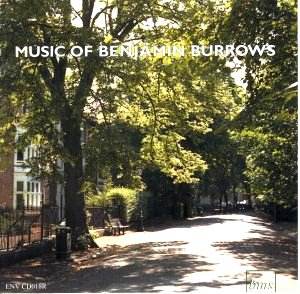These recordings were first issued on cassette in the
early 1990s. They represent one of the products of the advocacy of Brian
Blyth Daubney and Ronald Reah for a British composer usually thought
of (if thought of at all!) as a dismissable provincial. After all, what
we 'knowledgeably' dismiss need not distract us from continual dissection
and adulation of the familiar.
Burrows was a quiet and modest man who made his career
in Leicester, his birthplace, and never drifted from that city apart,
that is, for army service in the Great War. He came from a musical family,
his sister being a violist and the presumed dedicatee of his 1933 Viola
Sonata. He wrote songs, solo piano and organ pieces, chamber music and
orchestral pieces, and published many of them under his own imprint
- the Bodnant Press. His collection of scores and memorabilia is held
by the University of Leicester.
The British Music Society issued several Burrows recordings
on cassette. BMS403 presents a selection of Burrows' songs while ENV026
(for BMS members only) has some of his organ music and the very strong
Five Psalms alongside his other choral music. Details of BMS
membership and of these and other recordings can be obtained from this
website or from Stephen Trowell, 7 Tudor Gardens, Upminster, ESSEX
RM14 3DE, UK, 01708 224795. No email I am afraid.
While these tapes are late analogue they present a
very strong and well defined sound image. In the two duo sonatas the
instruments are assertively balanced without being aggressively forward.
A nice balance is also achieved for the songs and solos.
The Viola Sonata is passionate and bathed in Delian
warmth. It is nowhere near as dark as Bax's daemon-haunted Viola Sonata
or as turbulent as Arthur Benjamin's 1945 Viola Sonata. It has more
in common with Cyril Rootham's Violin Sonata (once recorded on a private
LP alongside the Flute Sonata). The Burrows is in almost constant song
- steering clear of folk influence except at a very subliminal level.
The other parallels are Howells' first two sonatas, the first Ireland
and Dunhill's first. It is a strong work and one to which you will want
to return. Of similar mindset is the Violin Sonata which has the sunset
quality of the Delius Violin Concerto, violin sonatas and, perhaps most
clearly, the Cello Sonata. It ends in an approximation of a Baxian jig.
In the songs the soprano Catherine Roberts seems set
back a little in comparison with Brian Blyth Daubney. She has a strong
voice - thankfully not too operatic - and the placement works well though
words are lost from time to time. This loss is a pity given the lack
of texts from the otherwise pretty exemplary booklet - an unaffectedly
well designed article blessedly free from design coups. Nothing reads
quite so well as black print on white paper!
The songs can best be thought of as in the Howells
and Michael Head 'school'. This is simply to give you some impression
of style. Word choice is good and is it simple coincidence that de la
Mare was also strongly favoured by Howells? The Rossetti song is most
beautiful with a touch of Gurney's song 'Here lies a most beautiful
lady'. Queen Djenira is all warm exotic nights - a touch
of Szymanowski and Sorabji in Leicester. I can easily imagine this and
the Three Cherry Trees (a kindly cradling of a song) being sung
by the young Janet Baker as in the classic 1960s SAGA recording of Howells’
King David. The expressionist nightmare of Mistress Fell reminds
me of John Foulds' The Rider. It has the same eldritch air tracing
all the way back to Schubert's Erlkönig. Then come the simpler
Burns brevities. These are songs showing that Burns could be set very
adroitly by other composers than F.G. Scott. Thankfully Burrows has
far too much taste and inherent subtlety to sprinkle his inventions
with tartan tat. This is not a criticism of Scott - an extremely fine
composer. The de la Mare and Rossetti songs should be in the collection
of every lover of British song as should the songs of Margaret Wegener,
John Williamson and C.W. Orr.
The piano solos are varied and all are subtle. Leicester
Tune No 1 is gentle in manner modeled on that undemonstrative Palmgren
charmer - the West Finnish Dance (itself recorded by Moiseiwitsch).
The Rumba is a tensely chiming piece and bubbling with echoes
of Ravel's Cakewalk. Autumn and Arabesque (liquid
and Lisztian) are complex mood sketches. These pieces date from the
1940s and 1950s.
The reviewer declares his interest (non-financial)
as a member of the BMS and the editor of the BMS newsletter. Len Mullenger
declares his interest as one of the sponsors of the original recording.
Rob Barnett


